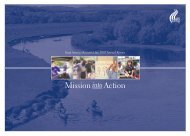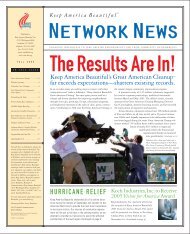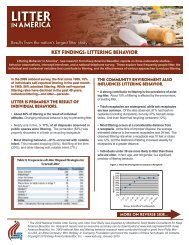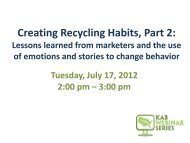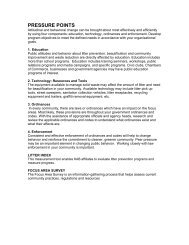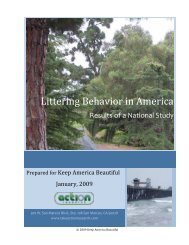NNewsSpring 2003 5_14 - Keep America Beautiful
NNewsSpring 2003 5_14 - Keep America Beautiful
NNewsSpring 2003 5_14 - Keep America Beautiful
Create successful ePaper yourself
Turn your PDF publications into a flip-book with our unique Google optimized e-Paper software.
KEEP INDIANAPOLIS BEAUTIFUL HELPS TRANSFORM URBAN SCHOOL<br />
<strong>Keep</strong> Indianapolis <strong>Beautiful</strong> involved hundreds of volunteers in the transformation of Cold<br />
Spring Academy, an urban public school in its community serving kindergarten through<br />
eighth grade students with diverse economic and social backgrounds. The school sits on 39<br />
acres of rolling land and formerly degraded woodlands slightly west of downtown Indianapolis.<br />
The site is one of only a few remaining landscape designs in Indiana by noted naturalist<br />
landscape architect, Jens Jensen, dating back to 1911. Sadly, the grounds had been ignored<br />
for nearly 60 years. Thirteen acres of forest had become overrun and degraded by exotic<br />
honeysuckle, privet, and Oriental bittersweet, which prevented native plants and healthy<br />
habitat from flourishing. The school asked <strong>Keep</strong> Indianapolis <strong>Beautiful</strong> to help restore the land<br />
as closely as possible to the original Jensen design, while also creating an outdoor classroom<br />
for its student body. The work began in the fall of 2001 and provided the opportunity for the<br />
students and staff to reclaim and restore the property surrounding their school.<br />
Teachers, students, and volunteers spent weeks pulling out brush and piling it into large<br />
40-cubic-yard dumpsters. Limbs were mulched for proposed nature trails throughout the<br />
woods. In the process, 100-year-old stone footbridge was uncovered, having been buried by<br />
the honeysuckle. Students unloaded 1,400 small saplings, and volunteers from three colleges,<br />
six middle/high schools, corporations and businesses, parents and grandparents, and professional/resource<br />
personnel joined the students and staff to take part in the massive business<br />
of planting the small trees.<br />
Several miles of paths were cut into the woods and volunteers built 12 picnic tables<br />
and stained them, finished a dock, and built and installed 30 bird boxes and nesting platforms<br />
throughout the grounds. Two large butterfly gardens, a medicinal garden and an herb garden<br />
with wildflowers were planted as well. Bulbs were planted at all entrances to the school, and<br />
wildlife-attracting shrubs were planted around the dock to encourage more wildlife.<br />
Last spring, hundreds of volunteers helped the school plant 63 more large trees with<br />
beaver wrap, 115 more shrubs, 35 flats of annuals, and 150 more perennials. This time students<br />
planted a vegetable garden, created an archeological dig, built two eight-foot bird blinds in the<br />
woods, constructed three eight-foot raised beds, built a tracking station, and installed a limestone<br />
amphitheater into a hillside following Jens Jensen’s theme of using council rings in his<br />
designs. The school curriculum now incorporates the outdoor classroom, and classes choose<br />
their area to maintain. Students harvest the produce from their vegetable garden, have class<br />
in their hidden Jensen council ring or near the various waterfalls on their property, and enjoy<br />
the gardens and butterflies from their classroom windows.<br />
INDIANAPOLIS,<br />
INDIANA<br />
Students of Cold Spring Academy cleaning and<br />
planting their outdoor classrooms and gardens.<br />
KEEP ISLIP CLEAN CONCLUDES RECORD-BREAKING CARD RECYCLING DRIVE<br />
In its 10th year of collecting card covers for reuse and recycling, <strong>Keep</strong> Islip Clean (KIC)<br />
announces that it has broken last year’s record by collecting 353,000 cards at the KIC office for<br />
shipping to St. Jude’s Ranch for Children in Boulder City, Nevada. Islip town residents, businesses<br />
and schools were involved in this annual effort, which enables thousands of pounds<br />
of waste to be eliminated from the town’s waste stream. According to KIC Director Nora<br />
Detweiler, cards are brought in from across the community – from schools to town government<br />
offices. KeySpan provides support for shipping and handling of the thousands of pounds of<br />
cards collected. KIC is looking to another successful drive in 2004, according to Detweiler.<br />
Local businesses, town government leaders and<br />
students support a record-breaking recycling effort<br />
in the Islip community.<br />
ISLIP,<br />
NEW YORK<br />
Community-Based Solutions Meet Technology<br />
THREE APPROACHES<br />
<strong>Keep</strong> Iowa <strong>Beautiful</strong> Litter Assessment<br />
ne <strong>Keep</strong> Iowa <strong>Beautiful</strong> (KIB)<br />
goal over the next 3-5 years is<br />
Oto reduce the volume of littering<br />
in Iowa by 50%. Partnering with the<br />
Iowa Department of Transportation<br />
recently, KIB identified a total of<br />
$13.5 million of public funds were<br />
spent on litter-related costs in Iowa.<br />
For its 2001 Roadside Litter<br />
Characterization Study, KIB identified<br />
a unique and effective integration of<br />
technology to help assess the state’s<br />
litter issue.<br />
Sue Smith, KAB’s director of<br />
education, reports that Gerry Schnepf,<br />
KIB’s executive director, utilized three<br />
corporations/agencies to develop Iowa<br />
data on the types of litter, sources<br />
of litter and Iowans’ litter-related<br />
opinions: Barker Lemar Engineering<br />
Consultants, Franklin Associates Ltd.,<br />
and the Iowa DOT.<br />
Barker Lemar offered this<br />
description of the technology customized<br />
for KIB to conduct a physical<br />
assessment of litter along Iowa<br />
roadways ...“We wrote an interface<br />
for users to collect data with tablet<br />
PCs that was related to GIS/GPS<br />
tracking technology. Some data was<br />
collected on hard copy too”. As an<br />
environmental engineering firm<br />
working with landfill sites and<br />
underground tank removal, Barker<br />
Lemar was able to translate KIB’s<br />
need for detail into a workable, user<br />
friendly tool to analyze litter conditions.<br />
Franklin Associates conducted<br />
a survey of costs for federal, state<br />
and local litter control as well as a<br />
review of legislation in Iowa and<br />
surrounding states. Iowa DOT conducted<br />
a direct mail survey of Iowans<br />
asking about three litter-related<br />
topics: litter and littering along<br />
Iowa roadways; littering behaviors;<br />
and, litter and dumping in local<br />
communities.<br />
Each aspect of this two-year effort<br />
was invaluable, and clarified or emphasized<br />
need for future action. Next<br />
steps? Create programs to reduce litter<br />
and use this model to measure KIB’s<br />
effectiveness over the next several<br />
years. For additional information,<br />
contact KIB’s Gerry Schnepf<br />
(www.keepiowabeautiful.com).<br />
(continued on page <strong>14</strong>)<br />
keep america beautiful — NETWORK NEWS — spring <strong>2003</strong> page 13



